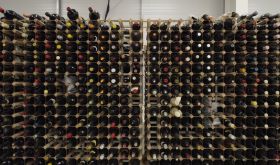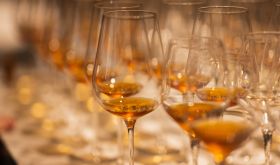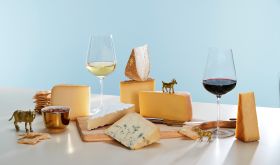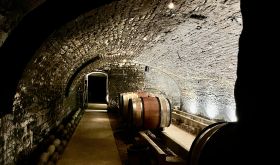Is California’s Zinfandel the most underrated grape variety in the wine world? It’s certainly underpriced compared with the state’s other dominant red-wine varieties Cabernet Sauvignon and Pinot Noir. According to the official 2024 crop report just published, the average price paid per ton of the famous French grapes was $2,162.29 and $1,694.62 respectively. The equivalent for Zinfandel? Just $667.68 even though so many of these Zinfandel vines are so venerable, and capable of making wine just as fine and long-lasting as the most expensive Napa Cab.
The future of these old vines is even more perilous now that the California wine industry is experiencing such a downturn that last year an estimated 35–40% of Zinfandel grapes were left on the vine in the old-vine Zin stronghold of Lodi (shown on this World Atlas of Wine map).
Zinfandel, whose origins were then mysterious, used to be California’s most widely planted red-wine vine before the 1990s fashion for aping the French classics took hold, to the detriment of Zin, of Shiraz in Australia and, subsequently, of Malbec in Argentina. The commonplace is generally undervalued, as was shown with Garnacha in Spain.
In the 1970s, when Paul Draper of Ridge Vineyards in the Santa Cruz Mountains overlooking Silicon Valley wanted to expand production from their then low-yielding Monte Bello Cabernet vineyard, Cabernet vines were too rare to fill the gap. So he took on an old vineyard they called Lytton Springs in Sonoma’s Dry Creek Valley (marked on this map of Northern Sonoma), which has come to be recognised as another hotspot for Zin.
The first vintage of Ridge Lytton Springs was 1972 (no bottles left) and the current winemaker John Olney has hosted vertical tastings designed to celebrate Lytton Springs’ half-century, one at the winery and another, last month, in London. The oldest vintages at the California event were 1974 and 1984, both in great shape according to my website colleague Alder Yarrow. In London, the oldest vintages, 1976 and 1989, were less vibrant but the next-oldest vintage, 1997, the first overseen by John Olney, nephew of the famous food and wine writer Richard Olney, was absolutely magnificent, as were the 2001, 2009 and all four of the younger vintages.
Admittedly, like Ridge’s other famous Sonoma estate Geyserville, the Lytton Springs vineyard is far from 100% Zinfandel. The heart of it was originally planted back in 1901 with what were known as ‘mixed blacks’, a random collection of different, mainly dark-skinned grape varieties dominated by Zinfandel but supplemented by Petite Sirah (Durif), Carignane (Carignan), Mataro (Mourvèdre) and others. The Ridge team use the old California names that would have been used by the largely Italian immigrants who settled in this bit of Sonoma from the 1870s onwards. According to Olney, ‘it’s magic how these varieties complement each other. Carignane brings acidity. Petite Sirah brings colour and tannin and then falls into the background.’ Ten years ago the Ridge team mapped each individual vine in this mosaic, and when one dies, they replace it with the same variety.
In our Lytton Springs tasting, the Zinfandel component varied from 67% in 2010 and 2022 to 90% in 1976, with the alcohol specified on Ridge’s exceptionally informative labels varying from 11.6% in 1976 to about 14.5% from 1997 onwards. Like Grenache, Zinfandel ripens relatively late and the wines tend to be fairly potent. Grapes on the same bunch can ripen inconsistently, which does nothing to moderate alcohol levels.
As you can see in my recommendations below, these wines don’t disappear from the market. In the UK, you can still find the delicious, fully mature 2010 for £80 a bottle, whereas, according to Wine-Searcher.com, a bottle of Ridge’s Cabernet-based Monte Bello from the same vintage would set you back between £207 and £360. I’ve enjoyed bottles of Ridge Geyserville in the past, too, but I find it takes time for the tartness from the Carignane portion, higher than in Lytton Springs, to integrate into the fruit.
Younger vintages of Ridge’s Zinfandel blends, and Zinfandels from less celebrated producers, cost much less, as my list shows. Inspired by the Lytton Springs tasting, I set about tasting every serious red Zinfandel available in the UK (many more can be found in the US of course, and an estimated half of Zinfandel grapes, the least promising, is turned into an inexpensive, sweetish pale pink wine labelled White Zinfandel). Although the Ridge style of Zinfandel is reasonably consistent – dense, complex, spicy wines designed to age for decades – my tasting at home vividly illustrated the exceptional versatility of California’s very own variety, the great majority of them based on spectacularly old, unirrigated bush vines in various pockets, celebrated by the state’s Historic Vineyards Society, all over the state.
Adam Sabelli-Frisch’s wine from Lodi was only 13.5% alcohol and he promises on the back label to have made ‘a lighter, more fresh style that emulates how California Zinfandels used to be made, before emphasis was put on extraction’. The wine didn’t lack flavour but it was quite refreshing and lively enough to enjoy with a fresh lobster salad. Extraction in the winery is designed to increase flavour and, especially, the tannin that confers a long life on a wine. But few Zins are characterised by being especially chewy, even if the two wines I tasted from each of Once & Future and Seghesio were most obviously made to last. (Zinfandels tend to mature quite a bit faster than Cabernets but, as the Lytton Springs tasting proved, they don’t necessary fall off their perch early.) The dominant character of all these wines was a certain sweetness from exuberantly ripe fruit, and I found in many of them a smell I can only describe as meaty, with the best of them having a lovely freshness, too.
Cheap red Zinfandel is all too easy to spot. It smells and tastes of very sweet berry jam, sometimes with a certain animal note, often with a layer of vanilla-flavoured American oak. Ridge is wedded to American oak, but always uses staves that are very carefully selected and well-seasoned. The variety seems to take ageing in French oak well, too, or even concrete, as Frog’s Leap’s version from Napa Valley shows. I admire any Napa Valley producer who, like Chateau Montelena, keeps their old Zinfandel vines in the ground. They could make so much more money from young Cabernet Sauvignon.
Ridge make at least 20 different Zinfandels or Zinfandel blends from vineyards all over the state. Producers with a reputation for their Zin tend to make a wide range of them, single-vineyard bottlings to honour those old vines. Robert Biale lists 20 different bottlings, Limerick Lane in Russian River Valley 11, Seghesio run by direct descendants of Italian immigrants 13. Morgan Twain-Peterson of Bedrock and his father Joel Peterson, who founded Zin specialist Ravenswood and is now devoted to his Once & Future label, are also wedded to the variety, as is Turley.
I do hope they will continue.
Recommended Zinfandels
Some of these wines, available in the UK, may seem expensive but they are all very fine.
Sabelli-Frisch, Faun, Lauchland Vineyard 2020 Jahant 13.5%
£23.50 Wanderlust Wine
St Amant, Mohr-Fry Ranches Zinfandel 2022 Lodi 15%
£27.90 Roberson Wine
Frog’s Leap Zinfandel 2022 Napa Valley 14.5%
£33.05 Justerini & Brooks
Joseph Swan, Zeigler Vineyard Zinfandel 2017 Russian River Valley 14%
£34 Wanderlust Wine
Bedrock, Old Vine Zinfandel 2020 California 14.5%
£34.95 NY Wines, £36.99 Selfridge’s
Once & Future, Green & Red Vineyard Zinfandel 2022 Napa Valley 15.5%
£39 The Wine Society
Chateau Montelena Zinfandel 2021 Calistoga 14%
£46 London End Wines
Ridge, Lytton Springs 2018 Dry Creek Valley 14.5%
£22.95 per half James Nicholson, £24 per half Mayfly Wine Co
Limerick Lane Zinfandel 2020 Sonoma County 15.1%
£52 The Wine Treasury
Ridge, Lytton Springs 2015 Dry Creek Valley 14.5%
£65 Roberson Wine
Ridge, Lytton Springs 2021 Dry Creek Valley 14.5%
Halves: £32.45 Roberson Wine, £32.50 Hedonism, £33 Four Walls Wine Company
Bottles: £56.34 Four Walls Wine Company, £72.99 Selfridge’s
Seghesio, Cortina Zinfandel 2021 Dry Creek Valley (15%)
£72 expected in the UK in July
Ridge, Lytton Springs 2010 Dry Creek Valley (14.4%)
£80 Hedonism
For tasting notes, scores and suggested drinking dates, see our tasting notes database. For international stockists, see Wine-Searcher.com.
Back to basics
| What is Zinfandel? |
|
For decades, Californians celebrated Zinfandel as their very own grape variety – except that it clearly belongs to the European vine species Vitis vinifera so it had to have come from Europe. It was long thought that Hungarian Sonoma vintner and showman Agoston Haraszthy imported the first cuttings in the mid 19th century but California historian Charles Sullivan proved that it had been offered by a Long Island nurseryman before Haraszthy ever crossed the Atlantic. In 1967, when in Puglia, a Californian plant pathologist was struck by how like Zinfandel the local Primitivo tasted and arranged for Primitivo cuttings to be sent to Davis, California’s leading wine research centre. They were planted alongside Zinfandel and indeed turned out to look extremely similar.
Now that DNA profiling has been developed, it would be relatively simple to analyse samples of the plant material and establish an identity but it was not until 1993 that the technique was applied to vine varieties. In 1975 a particularly bright PhD student at Davis established that the molecular profiles of the two vines were identical and by the late 1970s Pugliese wine producers started to label their Primitivo Zinfandel in the hope of improving sales.
But it had long been suspected that Primitivo had originally travelled to Puglia across the Adriatic from Dalmatia. Cuttings of a wide range of Croatian vines were accordingly sent to Davis for analysis. Finally, in 2001, a match was found, with a very rare local variety known locally as ‘the red from Kaštela’. Further research established that it had previously been known as Tribidrag. Much rejoicing in Croatia, but now the Montenegrins are claiming their version, known as Kratošija, has an even longer history, causing a bit of a brouhaha in the Balkans. |
| Full details of the 'Zinquest' are spelled out in our massive, award-winning tome Wine Grapes. |














